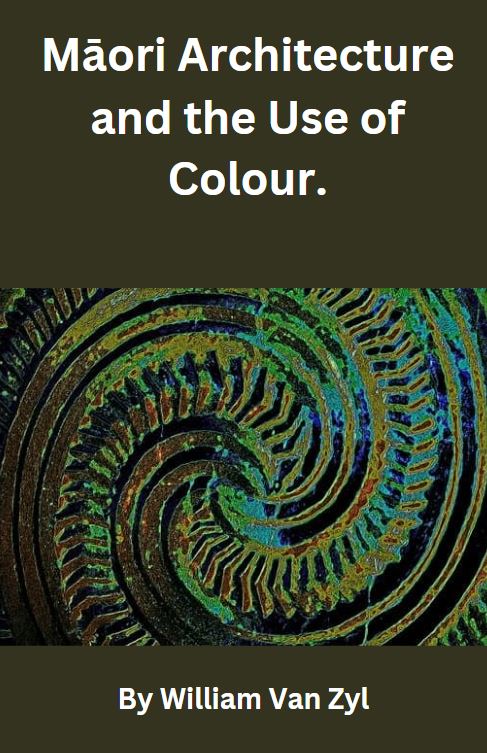
By William Van Zyl (Edited – 22 December 2023)
In this compact eBook, I look at colour and Māori architectural design. The resource is also useful to designers and artists – providing a rich background of Māori colours. Everyone interested in Global Architecture – and art and design – will find this book helpful. The Māori fundamental cultural colours and the accompanying shapes, forms, and patterns are also touched on. The resource can be used to compare and contrast different indigenous cultural designs against Māori culture. For example, Pasifika and Australian Aborigine cultures, to name a few. The eBook relates to the new Design and Visual Communication (DVC) curriculum (NCEA Level 1 – 2024) in New Zealand. It can be used in product and spatial (architectural) design. Identifying and exploring cultural colours for building and product design is a great starting point for unique design work.
At the end I include a lesson idea and several AI-inspired artwork. I endeavour to show Māori and Christian inspired shapes, forms, patterns and colours. Māori had been influenced by Christianity, and consequently, the values and beliefs were embedded in Maori culture. Don’t miss out on the cool Midjourney images at the end.
Table of Contents
Keywords:
Māori architecture, indigenous culture, New Zealand, symbolism, intricate carvings, connection to nature, colour, cultural meanings, spirituality, ancestral connections, meeting houses, vibrant colours, natural sources, themes, genealogies, storytelling, ancestral wisdom, carvings, patterns, cultural norms, spiritual beliefs, cosmological forces, cultural expression, identity, life force, mana, interconnectedness, symbolism, cultural continuity, harmonious dialogue, cultural heritage, spiritual realm, DVC NCEA Level 1, new design and visual communication curriculum NZ
Mātauranga Māori – Colour and Design: Kupe Centre in New Zealand is a window into the Māori World View.
TAUMATA O KUPE. Contemporary Spatial (Architectural) Design. Mātauranga Māori literally translated means ‘Māori knowledge’. It’s a modern term that broadly includes traditions, values, concepts, philosophies, world views and understandings derived from uniquely Māori cultural points of view. Aumata o Kupe embodies the epic journeys of Māori ancestors across the Pacific and within Aotearoa. Credit image: David Straight. Credit design: Toi Architects (NZ).
Kupe Center. Credit Toi Architects.
Kupe Center. Credit Toi Architects.
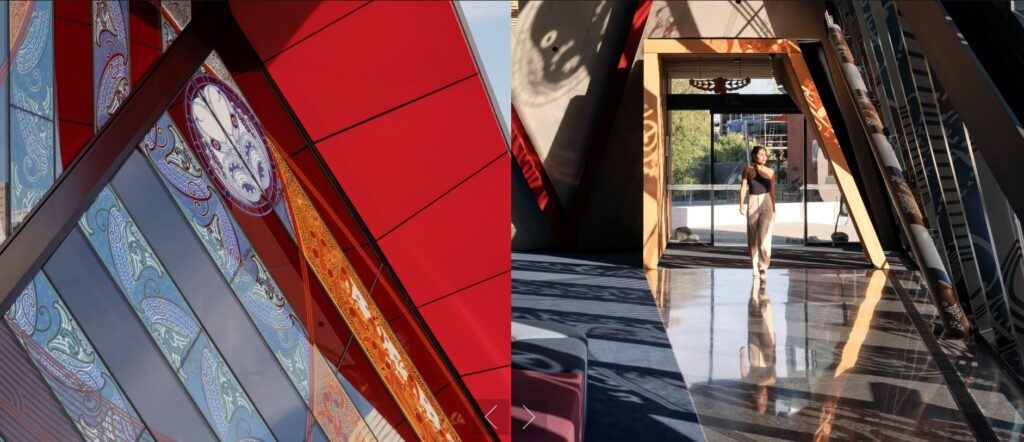
Shifting coloured shadows cast onto the floor, walls and waharoa through the glass frit during the day add to the sense that the interior is embellished by whakairo (decorations) and is moving through space like a waka. Design: Toi Architects NZ. Image: David Straight
Who is Kupe?
Kupe was a legendary Polynesian explorer who was the first person to discover New Zealand, according to Māori oral history. Whether Kupe existed historically is likely but difficult to confirm. He is generally held to have been born to a father from Rarotonga and a mother from Raiatea, and probably spoke a Māori proto-language similar to Cook Islands Māori or Tahitian. His voyage to New Zealand ensured that the land was known to the Polynesians, and he would therefore be responsible for the genesis of the Māori people.
The bronze Kupe Group statue is located on Taranaki Street Wharf. It depicts Kupe Raiatea, the great Maori explorer and discoverer of Wellington Harbour, his wife Te Aparangi and tohunga Pekahourangi. Wellington NZ.. Credit: By Heather Cuthill – Flickr: Kupe Statue, CC BY-SA 2.0, https://commons.wikimedia.org/w/index.php?curid=15332701
Poutama Wāhine design:
The stepped Poutama Wāhine design reflects Tāwhaki’s trip to the heavens. By mirroring the adjacent panels, it also represents the whakapapa of Tāwhaki and the family tree that he draws from his parents, Urutonga and Hema. Published: 08 Nov 2022. Source: https://www.habitatbyresene.co.nz/specifiers/honouring-Māori -tradition-with-design-and-the-resene-traditional-Māori -colour-palette/ Credit: Resene NZ.
Range of basic colours used in Māori art and design. Red, black, brown, and white. Credit: Pinterest https://pin.it/6cTBrmq
Symbolism and the basic Māori colours used in art and design:
White also symbolises purity, harmony, enlightenment, and balance.
Koru – the curling frond shape, the Koru, represents the unfolding of new life. It represents rebirth and continuity and promises renewal and hope for the future.
Red – represents Te Whei Ao, the realm of Coming into Being.
Kōwhaiwhai patterns
Kōwhaiwhai patterns differ from tribe to tribe, as they are derived from the environment where the tribe exists. They represent the mana of the house, ancestors and people.
Traditionally, Kōwhaiwhai patterns were red, black and white.
Red represents warmth, blood and life.
White represents purity, promise for the future and awakening.
Black represents the earth. Some believed the amount of red or black in a pattern might be related to the amount of prosperity an ancestor brought to the tribe.
Māori rafter patterns (patterns painted on the roof trusses exposed on the inside of a building) – red, black and white colours. By Godber, Albert Percy, 1876-1949
Credit National Library NZ. https://natlib.govt.nz/records/23245930
Introduction:
Māori architecture is deeply rooted in the indigenous culture of New Zealand’s Māori people and is characterised by its rich symbolism, intricate carvings, and close connection to nature. When it comes to the use of colour in Māori architecture, it plays a significant role in conveying cultural meanings, spirituality, and ancestral connections.
Colour holds cultural and spiritual significance in Māori architecture.
Traditional Māori buildings, such as meeting houses (“wharenui”) and other structures, often feature vibrant and earthy colours derived from natural sources like plants and minerals. These colours are carefully chosen to represent specific themes, genealogies, and spiritual elements.
Each hue holds a unique meaning and contributes to the overall narrative of the structure.
The use of colour in Māori architecture extends beyond mere aesthetics. It is a means of storytelling and a way to communicate ancestral wisdom. The intricate carvings and patterns, often adorned with colour, narrate past stories and connect the present with the ancestral lineage. The colour choices are informed by cultural norms, spiritual beliefs, and the desire to pay homage to the land, ancestors, and cosmological forces.
Colour in Māori architecture serves as a bridge between the physical and metaphysical realms. It enhances the spiritual significance of the structures, turning them into vessels of cultural expression and identity. The hues used in the carvings, paintings, and adornments represent the life force, mana (spiritual power), and the interconnectedness of all living beings.
Māori paint: Where did the pigments come from?
The vibrant hues adorning Māori building patterns and other artistic expressions were crafted from pigments sourced in harmony with their environment. These pigments, essential for their rich color palette, were derived from a variety of natural elements:
Clays and Earth: Red, yellow, and brown tones emerged from the diverse clays and earth found across New Zealand’s distinct regions.
Plant Extracts: Māori artisans harnessed the vibrant spectrum of plant extracts, tapping into the sap of specific trees or the juice from particular plant leaves to produce an array of pigments.
Charcoal: The burning of wood or organic matter yielded charcoal, a versatile material used to create deep black pigments.
Iron Oxides: Ochre, a mineral abundant in iron, contributed to pigments spanning shades of red, brown, and yellow.
Bone and Shell: Ground bone and shell were employed to produce white pigments, adding diversity to their color repertoire.
Natural Dyes: The Māori ingeniously utilised natural dyes from plant materials to infuse vibrant colors into fibers, shaping intricate patterns in their woven artifacts.
Beyond mere decoration, these traditional pigments held profound cultural significance, embodying elements of the natural world and encapsulating the spiritual beliefs of the Māori people. The utilisation of locally sourced materials underscored the resourcefulness and profound connection the Māori people maintained with their surroundings.
These traditional pigments were not only used for decorative purposes but also held cultural significance, often representing elements of the natural world and the spiritual beliefs of the Māori people. The use of these locally sourced materials reflects the resourcefulness and deep connection that the Māori people had with their environment.
Māori symbolism, spirituality, and cultural continuity:
The use of colour in Māori architecture goes beyond decoration; it is a language of symbolism, spirituality, and cultural continuity. Through careful selection and application of colours, Māori architecture – and art and design – creates a harmonious dialogue between the physical world, the cultural heritage, and the spiritual realm, resulting in structures that are not only visually captivating but deeply meaningful.

IMAGE: Here is an education resource to help you connect with the whenua (‘The land of the people’). Learn how to identify workable earth pigments in the taiao and turn that into paint using all natural materials. Link to the website: https://www.kauaeraro.com/home-1
Possible Lesson Idea – Use Māori pigments to create a self-portrait or a work of art (scuplture/acrylic/oil/watercolours/pencil).
If you are not Māori, research your own culture and heritage. Create a self-portrait (or any art) – elaborate on the symbolism. Use colours, shapes, forms, and patterns that are associated with your culture. Write a couple of paragraphs on the meaning of your artwork. Remember to focus on the colours too. Be open and a little vulnerable.
Are you Christian?
Show the influence of Christian values on Māori culture:
Have you been influenced by Christianity?
Show how Christianity had an impact and influence on Māori culture. Think about Māori and Christian colours – merge and contrast. Endeavour to merge the two perspectives into one – maybe design a building, maybe design a self-portrait, maybe consider abstract or contemporary art.
I have asked AI (Midjourney) to design art contemporary Māori work:
PROMPT: Maori-inspired artwork for a self-portrait: Focus on abstract or contemporary art. Merge Māori and Christian shapes, forms, patterns, and colours. Ensure the basic Māori colours like red, white and black are included.

IMAGES: AI-inspired contemporary Māori Art (Midjourney).

IMAGE: I favour this design. See the typical white, black, and red Māori colours.
Abstract Maori Art: AI-inspired
PROMPT: Abstract Māori art merged with Christian shapes and forms.
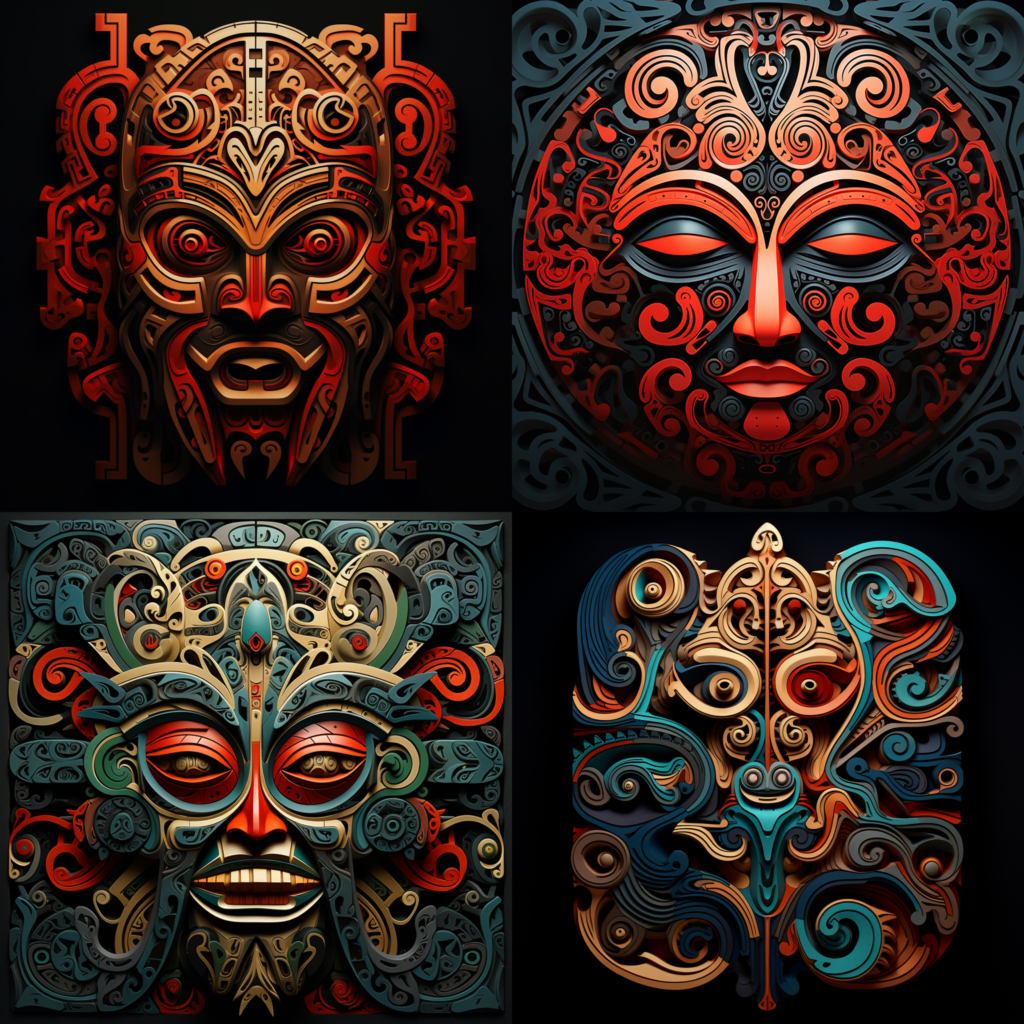
IMAGES: Abstract/contemporary approach. I don’t recognize any Christian features and colours in these images.

IMAGE: I favour this one. Can you identify the Māori colours? See the red, and white (cream) on the black background. The blue ‘teal’ is a great addition to lift the art work into a contemporary bracket.
Abstract Christian Artwork:
PROMPT: Abstract Christian Art: Include the Christian shapes, forms and patterns in the artwork.

IMAGES: Can you identify the Christian shapes, forms, and patterns?

What do you see?

What do you see? Christian theme: CIRCLES – am the Alpha and the Omega (‘beginning and the end).

What do you see?

IMAGE: I favour this one. Can you recognise the Christian theme? “The Cross, the Cross, and the Cross” Stunning!
Now consider a combination of Maori and Christian architecture – a mix.
PROMPT: Abstract architecture: Include a mix of Maori and Christian shapes, forms, patterns, and colour in the same building.

IMAGES: Very colourful and very busy. A huge range of shapes, forms, patterns, and colours.



These colourful images reminds of the work of Friedensreich Hundertwasser in New Zealand. Outstanding ceramic & tile work (mosaics). Here is an example of his work:
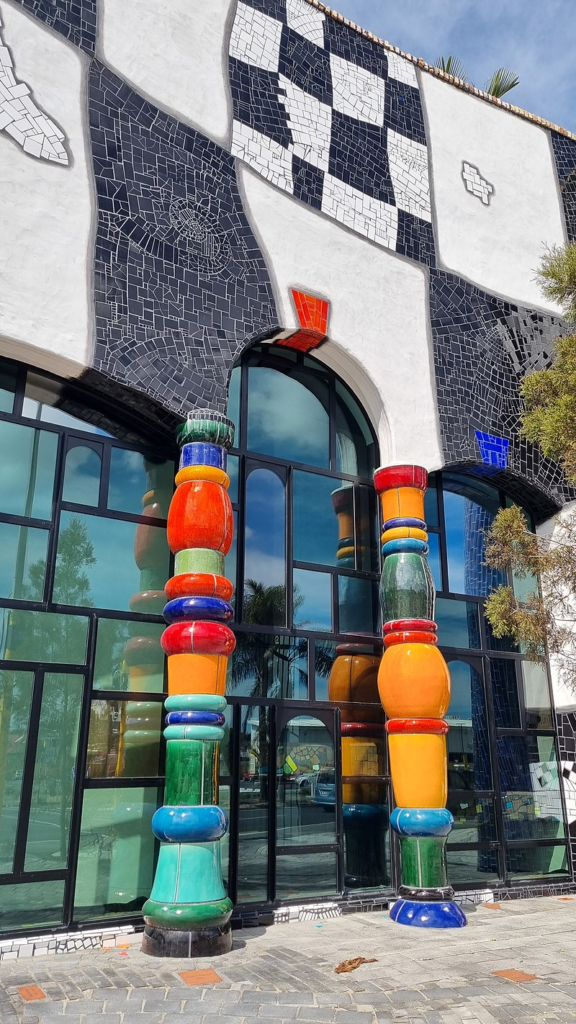
IMAGE: The Hundertwasser Art Centre with Wairau Māori Art Gallery is an art and cultural centre in Whangārei, New Zealand. It is the conception of artist and architect Friedensreich Hundertwasser who lived near Kawakawa for 30 years and was first designed in 1993. The project proved controversial and was considered and rejected a number of times until it was approved by a binding referendum in June 2015. Credit images: Wikipedia.

| Friedensreich Hundertwasser | |
|---|---|
| Hundertwasser in his second homeland New Zealand in 1998 | |
| Born | Friedrich Stowasser 15 December 1928 Vienna, Austria |
Minimalist Architecture:
PROMPT: Minimalist Architecture: A mix of Maori and Christian concepts in a building. Very simple design.
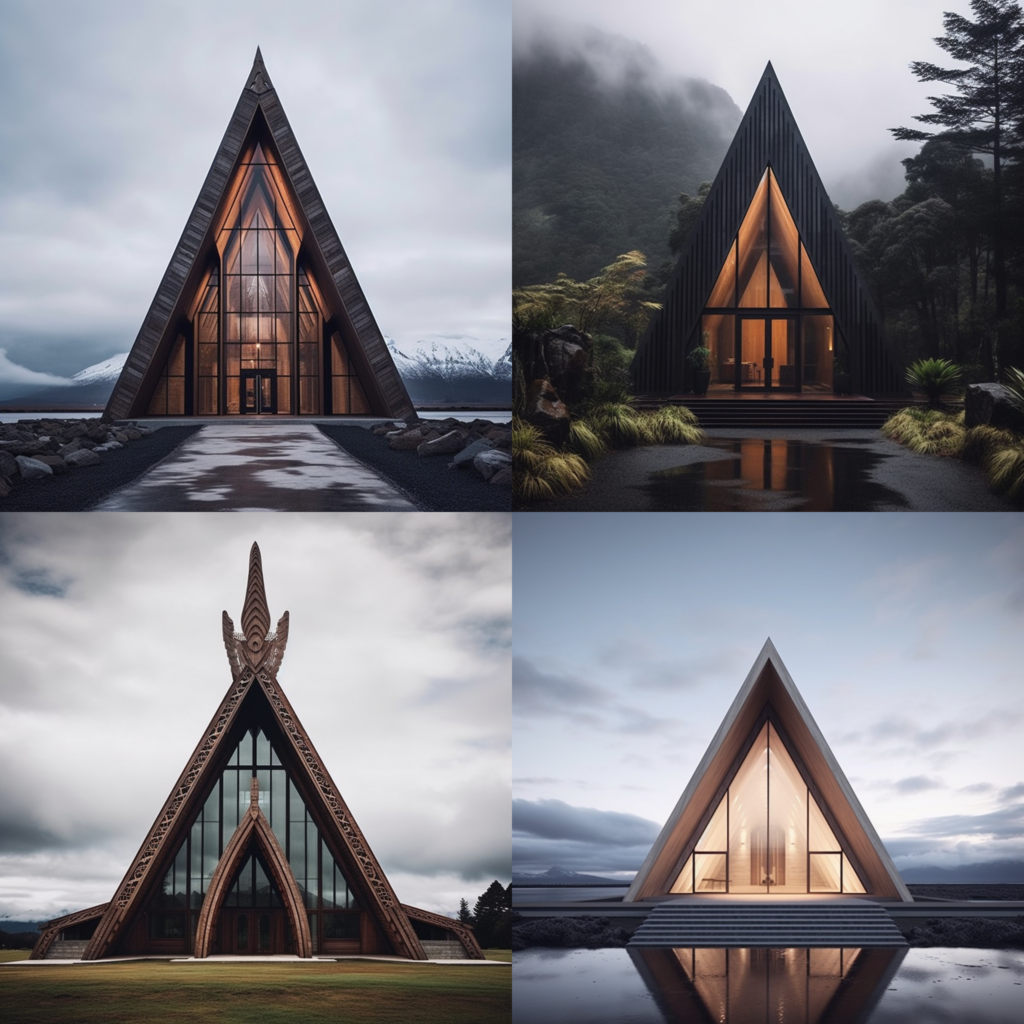
IMAGES: Can you recognise the Christian shapes and forms in these buildings? Typical church and temple roof styles. Can you see the Māori Marae/Whare (meeting house/ house) shapes?



IMAGE: I favour this one. See the Māori carvings (motifs) combined with the Christian church gable shape. Monotone colours – very organic. Natural wood – decorative carved fascias.

It is your turn: What will you design?
Interested in more Māori resources on architecture, food, fashion, furniture, tools, worldview, AI, and more?
Search the blog posts: ‘Māori‘
Here are some examples of the many articles and resources available: Māori context (metalwork, woodwork, furniture, food, tools, worldview, placenta, AI, Modernist architecture [Le Corbusier – Villla Savoye and others], and much more).
Citation:
Van Zyl, W. (2023). Māori Architecture and the Use of Colour. Five House Publishing. https://fivehousepublishing.com/2023/08/21/maori-architecture-and-the-use-of-colour/
Copyright © 2023 by William Van Zyl
Māori Architecture and the Use of Colour.
All rights reserved. This eBook/article or any portion
thereof may not be reproduced or used in any manner
without the publisher’s permission, except for using brief quotations in a book review.
Published by Five House Publishing (New Zealand)
First Publishing, October 2023
Edited: 21 December 2023
More eBooks and articles are available at https://fivehousepublishing.com/
More about the author at http://williamvanzyl.com/